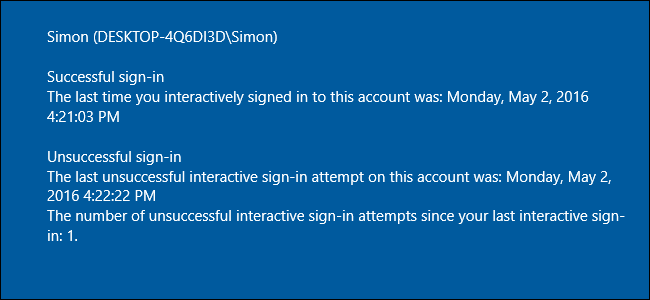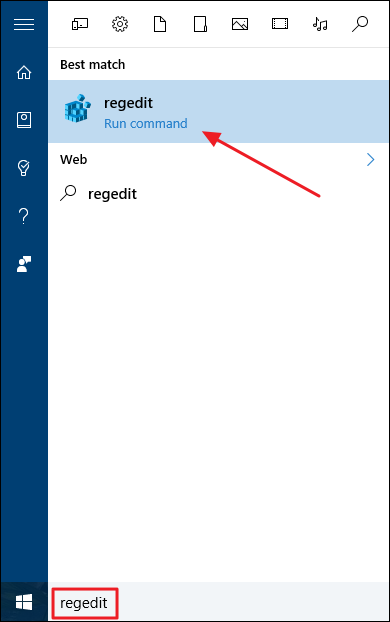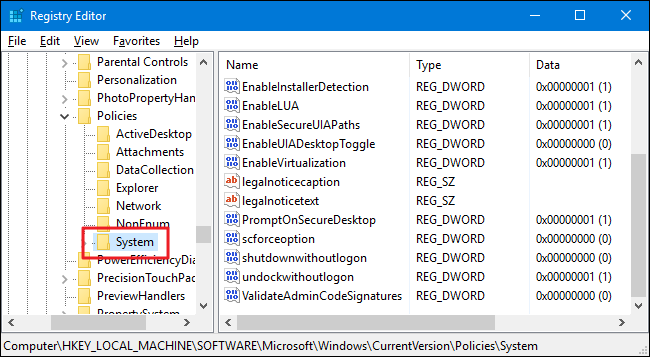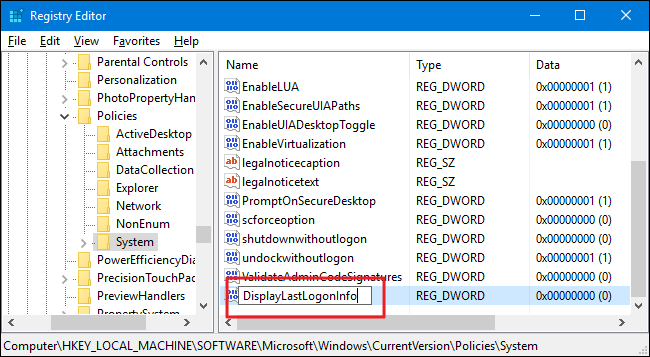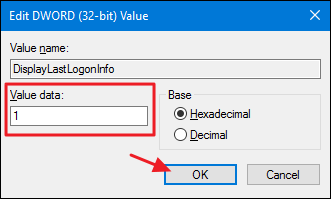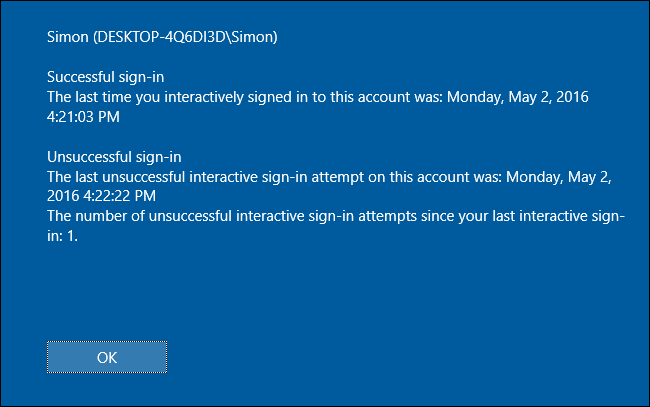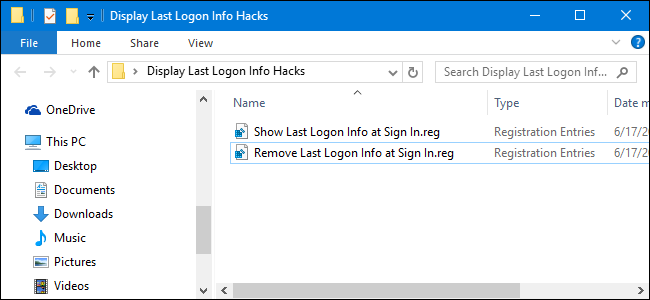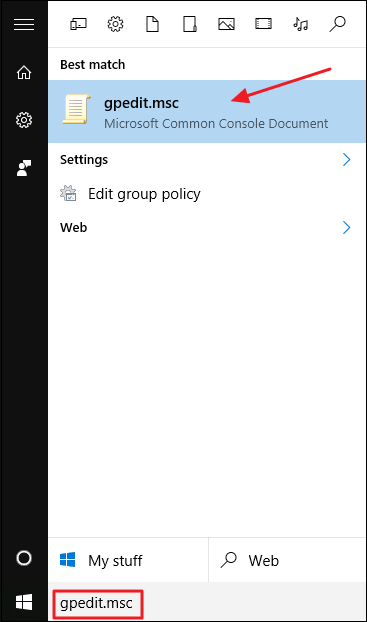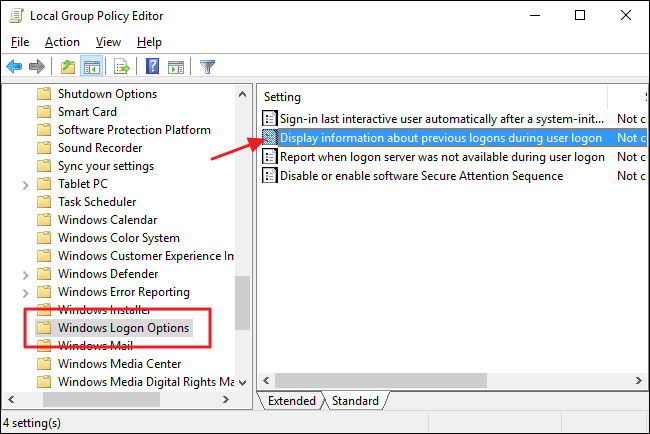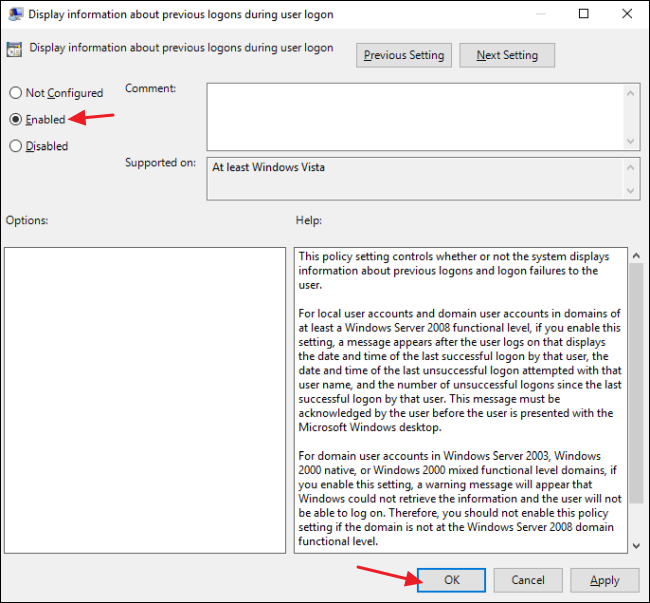Quick Links
By default, most versions of Windows record an event every time a user tries to log on, whether that log on is successful or not. You can view this information by diving into the Event Viewer, but there's also a way to add information about previous logons right on the sign in screen where you can't miss it. To make it work, you're going to have to dive into the Windows Registry or, if you have a Pro or Enterprise version of Windows, the Group Policy Editor. But don't worry. The changes are pretty simple and we'll walk you through them.
This technique works in every version of Windows from Vista on up, but of course there are a couple of caveats. The first is that, in Windows 8 and 10, this trick only works with local accounts, not Microsoft accounts. If you have both types of accounts on one computer, you can still use this technique, but it will only display information when you sign in with a local account. The second caveat is that if you have Windows set up to log on automatically, you won't see the extra screen with logon info.
Home Users: Show Previous Logon Information by Editing the Registry
If you have a Windows Home edition, you will have to edit the Windows Registry to make these changes. You can also do it this way if you have Windows Pro or Enterprise, but just feel more comfortable working in the Registry as opposed to Group Policy Editor. (If you have Pro or Enterprise, though, we recommend using the easier Group Policy Editor, as described in the next section.)
Standard warning: Registry Editor is a powerful tool and misusing it can render your system unstable or even inoperable. This is a pretty simple hack and as long as you stick to the instructions, you shouldn’t have any problems. That said, if you’ve never worked with it before, consider reading about how to use the Registry Editor before you get started. And definitely back up the Registry (and your computer!) before making changes.
To get started, open the Registry Editor by hitting Start and typing “regedit.” Press Enter to open Registry Editor and give it permission to make changes to your PC.
In the Registry Editor, use the left sidebar to navigate to the following key:
HKEY_LOCAL_MACHINE\SOFTWARE\Microsoft\Windows\CurrentVersion\Policies\System
Next, you're going to create a new value inside that System subkey. Right-click the System icon and choose New > DWORD (32-bit) Value. Name the new value DisplayLastLogonInfo.
Next, double-click the new DisplayLastLogonInfo value to open its properties window. Change the value from 0 to 1 in the "Value data" box and then click OK.
You can now close the Registry Editor. The next time you sign in to Windows, after entering your password, you will see a display that shows you the last successful logon and any unsuccessful logon attempts. You'll have to click OK to finish signing into Windows.
If you want to reverse these changes, all you have to do is return to the Registry Editor and change the DisplayLastLogonInfo value from 1 back to 0.
Download Our One-Click Registry Hack
If you don’t feel like diving into the Registry yourself, we’ve created two downloadable registry hacks you can use. One hack shows the previous logon info on the sign in screen and the other removes that info, restoring the default setting. Both are included in the following ZIP file. Double-click the one you want to use, click through the prompts, and then restart your computer.
These hacks are really just the System key, stripped down to the two values we described above, and then exported to a .REG file. Running the “Show Last Logon Info at Sign In” hack changes the DisplayLastLogonInfo value to 1. Running the “Remove Last Logon Info at Sign In Personal Info at Logon” hack sets the value back to 0. And if you enjoy fiddling with the Registry, it’s worth taking the time to learn how to make your own Registry hacks.
Pro and Enterprise Users: Show Previous Logon Information with the Local Group Policy Editor
If you’re using Windows 10 Pro or Enterprise, the easiest way to show previous logon information at sign in is by using the Local Group Policy Editor. It’s a pretty powerful tool, so if you’ve never used it before, it’s worth taking some time to learn what it can do. Also, if you’re on a company network, do everyone a favor and check with your admin first. If your work computer is part of a domain, it’s also likely that it’s part of a domain group policy that will supersede the local group policy, anyway.
In Windows 10 Pro or Enterprise, hit Start, type gpedit.msc, and press Enter.
In the Local Group Policy Editor, in the left-hand pane, drill down to Computer Configuration > Administrative Templates > Windows Components > Windows Logon Options. On the right, find the “Display information about previous logons during user logon” item and double-click it.
In the properties window that opens, select the Enabled option and then click OK.
Exit the Local Group Policy Editor and restart your computer (or sign out and back in) to test the changes. If at any time you want to remove the logon information from the sign in screen again, just follow the same procedure and set that option back to disabled.
And that's it. If you're using any version of Windows from Vista through 10 (remember, local accounts only in Windows 8 and 10), you can have Windows display previous logon information whenever a user signs in. At the very least, knowing whether or not other people have tried logging onto your user account is good information to have. And putting that information right on the sign in screen makes it hard to miss.

